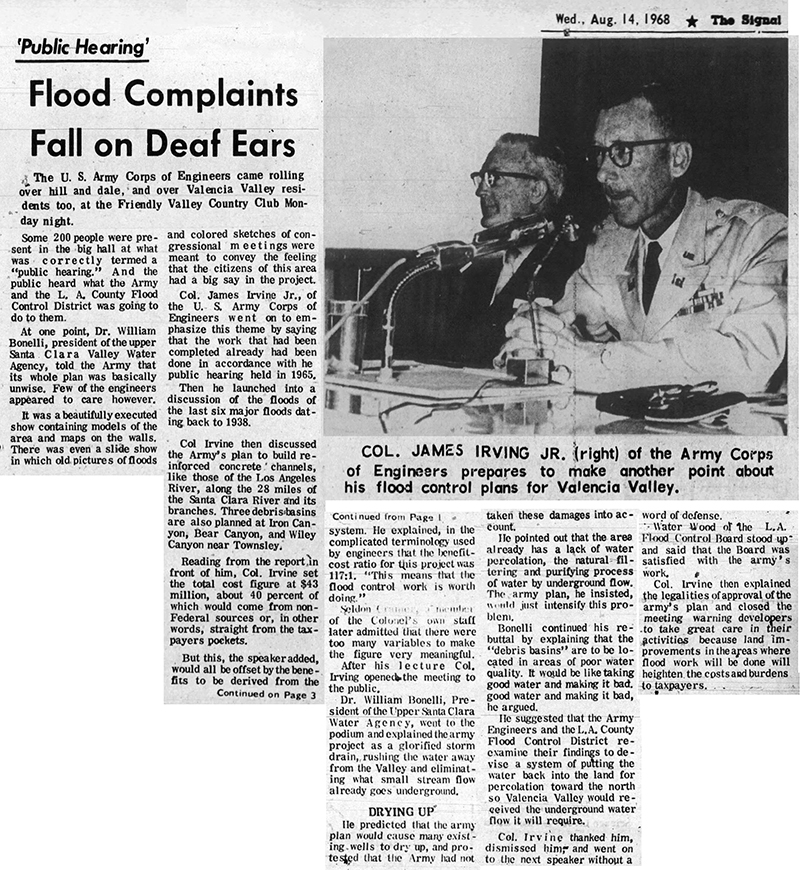Army Corps to Turn Santa Clara River Into L.A.-Style Concrete Channel.
L.A County Flood Control District Endorses Plan; Residents and Local Water Agency Object.
|
Photos (35mm negatives, Kodak Safety Film) by Mark (Cowell?) / The Signal.
Webmaster's note.
What a difference a few decades make: In the early 21st Century, the primary function of the U.S. Army Corps of Engineers locally is to prevent development and other human activity from impeding the natural flow of the Santa Clara River and its tributaries. USACE's channelization plan did not come to fruition. Public Hearing Flood Complaints Fall on Deaf Ears. The Signal | Wednesday, August 14, 1968. The U.S. Army Corps of Engineers came rolling over hill and dale, and over Valencia Valley residents too, at the Friendly Valley Country Club Monday night. Some 200 people were present in the big hall at what was correctly termed a "public hearing." And the public heard what the Army and the L.A. County Flood Control District were going to do to them. At one point, Dr. William Bonelli, president of the upper Santa Clara Valley Water Agency, told the Army that its whole plan was basically unwise. Few of the engineers appeared to care, however. It was a beautifully executed show containing models of the area and maps on the walls. There was even a slide show in which old pictures of floods and colored sketches of congressional meetings were meant to convey the feeling that the citizens of this area had a big say in the project. Col. James Irvine Jr. [cq] of the U.S. Army Corps of Engineers went on to emphasize this theme by saying that the work that had been completed already had been done in accordance with the public hearing held in 1965. Then he launched into a discussion of the floods of the last six major floods dating back to 1938. Col. Irvine then discussed the Army's plan to build reinforced concrete channels, like those of the Los Angeles River, along the 28 miles of the Santa Clara River and its branches. Three debris basins are also planned at Iron Canyon, Bear Canyon, and Wiley Canyon near Towsley. Reading from the report in front of him, Col. Irvine set the total cost figure at $43 million, about 40 percent of which would come from non-Federal sources or, in other words, straight from the taxpayers' pockets. But this, the speaker added, would all be offset by the benefits to be derived from the system. He explained, in the complicated terminology used by engineers, that the benefit-cost ratio for this project was 117:1. "This means that the flood control work is worth doing." Seldon Cramer, a member of the Colonel's own staff, later admitted that there were too many variables to make the figure very meaningful. After his lecture, Col. Irvine opened the meeting to the public. Dr. William Bonelli, President of the Upper Santa Clara Water Agency, went to the podium and explained the army project as a glorified storm drain, rushing the water away from the Valley and eliminating what small stream flow already goes underground. Drying Up. He predicted that the army plan would cause many existing wells to dry up, and protested that the Army had not taken these damages into account. He pointed out that the area already has a lack of water percolation, the natural filtering and purifying process of water by underground flow. The army plan, he insisted, would just intensify this problem. Bonelli continued his rebuttal by explaining that the "debris basins" are to be located in areas of poor water quality. It would be like taking good water and making it bad, he argued. He suggested that the Army Engineers and the L.A. County Flood Control District reexamine their findings to devise a system of putting the water back into the land for percolation toward the north so Valencia Valley would receive the underground water flow it will require. Col. Irvine thanked him, dismissed him and went on to the next speaker without a word of defense. [Walter] Wood of the L.A. Flood Control Board stood up and said that the Board was satisfied with the army's work. Col. Irvine then explained the legalities of approval of the army's plan and closed the meeting warning developers to take great care in their activities because land improvements in the areas where flood work will be done will heighten the costs and burdens to taxpayers.
Download original images here. Signal Photo Archive, Santa Clarita Valley Historical Society collection.
|

